Intern Thoughts: A Weekly Response
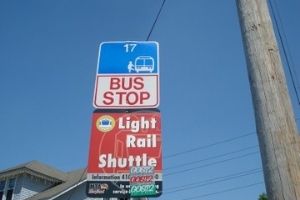
Every week we’re asking our summer interns to share some thoughts and responses to various experiences and readings. This week we asked them to report on a “Baltimore Experience.”
By the Rocket’s Red Glare
One of my favorite free things to do in Baltimore is to take walks on the grounds of Fort McHenry. The views of the harbor are beautiful; I could sit for hours and just look at the ships and boats passing by. It’s also a great place to sit on the grass and have a picnic. The path around the perimeter borders the harbor, so there is always a nice breeze flowing through. Also, you can see the fort’s giant American flag from nearly anywhere on the grounds. If you enjoy taking pictures, there are plenty of opportunities for patriotic photos!
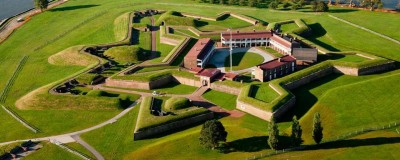
Beside the fort itself, a great landmark at Fort McHenry is the 24-foot-tall statue of Orpheus, which is a monument dedicated to Francis Scott Key, at the end of the path. I look forward to seeing it on all of my trips! Be sure to pay special attention to the statue’s eyes; they have life-like dimension that always impresses me. Fort McHenry defined Baltimore’s history, and it’s still a great place to visit!
~Alice Wynd
Baltimore and the Star-Spangled Banner
Baltimore has a rich history surrounding the War of 1812 and the writing of the Star Spangled Banner, our national anthem. As a group, the interns were able to attend the celebration of Flag Day at the Flag House. There was fanfare, the youth fief and drum core from Fort McHenry attended and played several songs. We were lucky enough to have great weather that day as we sat outside for speeches and the raising of the flag, but my favorite part of that day was getting to go inside the house where Mary Pickersgill and her assistants worked on the flag before they brought it to the brewery to sew the enormous thing together.
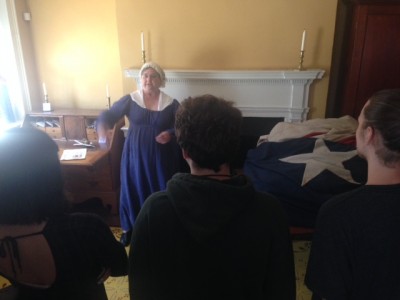
Mary and her only surviving daughter moved back to Baltimore after the death of her husband, John Pickersgill. Mary’s mother was already living in Baltimore and moved in with her daughter and grand-daughter when they bought their house. The flag business that Mary developed gave her a reputation for producing fine work and led George Armistead, the commander at Fort McHenry, to commission her in making a flag “so large that the British will have no difficulty seeing it from a distance.” She was able to finish the flag in six weeks and a magnificent flag; it was quite a sight flying over the fort.
The house held a few things that had belonged to the Pickersgill family, including two vessels that had remains of coffee and cocoa in them. Not only was Mary working well enough to attract the attention of Armistead, but she was making a tidy profit from her independent business. Mary was a rare sight for her time. Many women were not able to secure the independence she found in the flag making business; Mary was an independent and successful woman making her own way in a man’s world. She inspired, through her handiwork, Francis Scott Key’s “Star-Spangled Banner.”
~Rebecca Miller
A Diverse Baltimore
This weekend, while working at My Thai in Little Italy, I had a very distinctly Baltimorean experience. The Chef asked me to run over to a bodega down the block and pick up some bananas and sugar. On the way there, I walked past the Perkins Homes public housing project, past some abandoned and decrepit properties, and into the store, where nobody (besides myself) spoke any english. The smell of tacos and chile relleno in the store was intoxicating, and I left inspired. I, a white Jew from Owings Mills, left the posh restaurant where I work for a Thai immigrant, passed the projects, and went into an entirely spanish speaking bodega, all in the same block.
This kind of diversity and community blending is unique to Baltimore, and is something I’m extremely proud of. This kind of cultural mixing is what makes America great, and helps me to justify the existence of a nation that was founded on the genocide of Native Americans and the enslavement of African peoples as much as it was founded on the Enlightenment ideals of liberty, the sovereignty of the people, and self-determination.
~David Agronin
Bawlmer’s Best Time
Although I’ve been attending Johns Hopkins University for three years, this is the first summer I’ve spent in Baltimore and I’ve been using it to explore and experience Baltimore in a way that’s impossible when school’s in session. So far, the most uniquely Baltimore experience I’ve had is at HON fest in Hampden on the weekend of June 12th. HON fest, in case anyone reading this is not from Baltimore and is even more “Bawlmer” illiterate than me, is a yearly festival in Hampden celebrating the classic Baltimorean endearment “hon”, short for “honey” and 1960’s style, a combination which I’m still confused about even after attending the festival and doing research for this post—clearly there are some parts of Baltimore that I can never understand.

HON fest was a blast, though—sixties-style bands and all the crab and seafood stands you can possibly imagine, hair stylists teasing hair as high as it would go, go-go boots on dancers and iced tea and lemonade to conquer the Baltimore heat. My friends and I wandered up and down the street, soaking up a uniquely Baltimore atmosphere. From finally seeing the giant pink flamingo that is so iconically Baltimore to watching my friend eat oysters, surprisingly I felt like a part of this warm city and not just a student tourist.
~Gina Crosby
We All Scream for Ice Cream
Every day as I make the walk from the metro to the Jewish Museum I pass an old factory. The factory itself has beautiful architecture with ornate arches and windows. The red brick factory has the outline of Hendler’s Creamery Co. with an H and two C’s in circles on the center three window arch pillars. At first I thought it was just another abandoned factory, but as I was working on inventory, the name kept coming up on old signs. At first I didn’t make the association but after doing a bit of web research I found that the Hendler’s Creamery Company held an important place in Baltimore history.
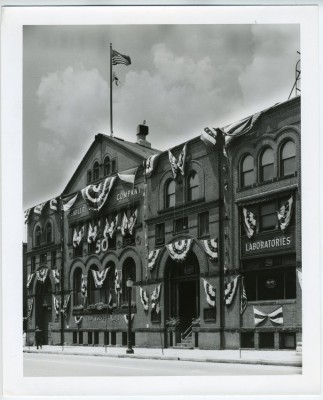
The old Hendler’s Creamery Company building was where Hendler’s ice cream was produced from 1912 until sometime in the 60s. The ice cream was at one time one of the most popular brands in Baltimore. Before that it was theater, hosting movies, vaudeville and pieces preformed in Yiddish, to list some of its attractions. Before that it belonged to the Street car company. The Maryland Historical Society has written a nice piece on the history of the company.
Now the factory lies in a state of disrepair, waiting to start the next part of its life. In 2012 the building was bought by a developer for 1.8 million, with a plan to make it into luxury apartments. Redevelopment of the historic property was slated to begin in 2014, but changes in the plans have pushed the start date back. As of yet a new start date has not been projected.
~Tamara Schlossenberg
A Marine Melting Pot
As cliché as it sounds I’ve always loved the aquarium. I know, it is one of the biggest tourist attractions and as a native you would think I would be able to come up with something a little more “hole-in-the-wall”-esque, but even as an adult there is something about the size of it and the variety of marine life that intrigues me.
When I was taking my foundation classes freshman year I made a whole book about the Aquarium solely because I knew I could get some cool images from it. The book itself was an accordion book and it had a very grid like pattern similar to the roof of the very geometric building. Anyway, I had images of jellyfish and sharks and other marine animals and I just began to think about the vastness of the ocean and how much we actually don’t know.
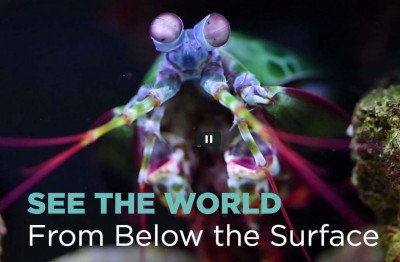
Now, how does all of this relate back to Baltimore? The National Aquarium is home to more than 660 animal species. That is way more than a “shark” or a “jellyfish”, and they all live in there together in this one building. Baltimore is home to around 630,000 people, and all of them are so different. There are so many different cultures, races, languages, and religions etc., which all live together in this one city. Just like the aquarium, even though not everyone speaks the same language or believes in the same thing, there is unity within the city.
~ Rachel Morin
From the Bay Area to the Old Bay: A West Coast Perspective on Baltimore and the Chesapeake
I lived in the Bay Area on the west coast for most of my life; unlike the southern California beaches I was used to the cold water bay. When I moved to Baltimore I had no real expectations or preconceptions; what I had known about Maryland as a whole when we moved was very limited: 1. We had family there, 2. Some wars had happened there. I arrived in the beginning of the summer, I didn’t really know anyone so I was quickly enrolled in Summer school to get my (abysmal) grades up and keep me out of trouble for the time being. One thing I had sort of become accustomed to in the Bay Area was having the same weather pretty much year around. Well the rest of the world actually has REAL seasons. That means hot, humid summers…..and cold winters, cold winters with snow. Pretty sure my neighbors had a good laugh at my attempting to shovel snow the first time.
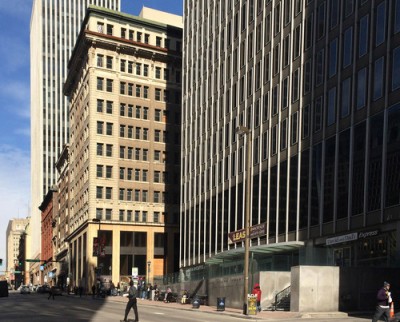
The most iconic East coast experience I can remember would be waiting for the bus to get home. Every bus stop was a different social sphere and had a different atmosphere, as is the nature of midsized cities and Baltimore especially. You can follow the same street that runs through Bolton hill down through Sandtown. Baltimore is a medley of neighborhoods all so close to each other but so different and distinct in not only their levels of affluence but their history and the inhabitants living there.

Another prime example being Guilford and Greenmount Avenue, so close and so different. The bus stops downtown and in Mt. Vernon are social spaces where people from all over the city converge to catch very similar buses. I met a huge variety of people just in my time waiting for my bus, it is an experience that truly cultures someone. It wasn’t always pleasant, people weren’t always friendly, but overall it was definitely one of the ways I learned the most about the place that I live. Spending that much time around such a variety of people is a vital part of growing up and being an understanding and socially aware adult. There is only so much a white boy like myself from north Baltimore can learn about the rest of the city unless you go out and interact with people from the rest of the city.

Whether I chose to wait at Penn. Station or downtown Fayette Street or Mount Vernon the crowd of people I would meet was diverse. I had and continue to have some great conversations with some really interesting people in varying stages of their life. Sometimes it made the end of my day very interesting, other times stressful. Either way it introduces you to the people of your city and that is a truly unique and enlightening experience; my experiences really shaped the way I feel about Baltimore.
~Cade Simon
Going the Distance
I have been a completive distance runner for seven years, ever since my parents encouraged me to try a Fall sport. In Autumn of 2009 I began Cross Country at Pikesville High where I also ran track in the Winter and Spring. I eventually started running road races, and this is where I discovered what I love most about Baltimore; the running community.
I’ve attended plenty of road races over the years. While they all have a special dynamic of their own, I have noticed something consistent about all of them. The attendees are comprised of passionate, driven people who all have their own reason for running the race. Some people are fundraising for a cause, others need to prove something to themselves and others simply want to spend a morning with their family in the fresh air.
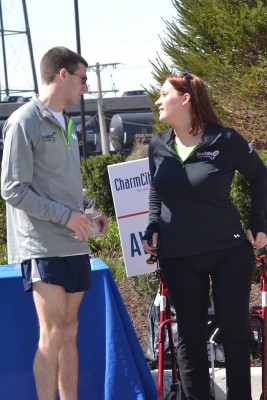
My favorite race is the Sole of The City 10K. A challenging, yet beautiful course and a great race atmosphere; I highly encourage anyone reading this to consider running the race. In 2014, the event was benefiting the Erika Brannock Foundation. Erika, pictured below, was injured in the 2013 Boston Marathon Bombing. A portion of her left leg was amputated, her right leg was damaged as well. The race, to me, was symbolic of Baltimore’s support for Boston, as well as Erika’s first year of recovery.
Before the race Erika (pictured below) gave a speech encouraging the runners, and declaring that she would not stop her recovery until she was able to walk again. I can clearly remember the applause that followed her speech. After the race, I found out I had won my age group division. Erika was distributing awards. I quickly thanked and congratulated her on her recovery. I also told her that people like her are what continue to inspire me to pursue a career in teaching.
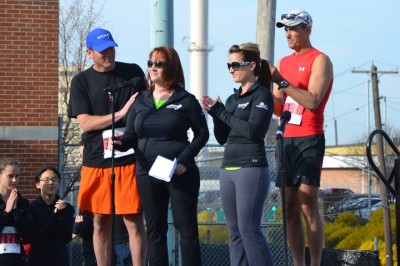
This exemplifies what I love about Baltimore Running: this community loves their own. The Baltimore Marathon saw a whole city uplift Dave Berdan, as he became the first local runner to win the event. Back On My Feet, a nonprofit where I also interned for a Summer, has helped countless people combat homelessness. Running stores, such as Falls Road or Charm City, welcome experienced athletes, as well as anyone who wants to begin running. The runners in this city have big goals, big spirits and even bigger hearts.
If anyone in Baltimore is nervous about taking up running I can promise you; this is the place to do it.
~Ben Snyder
Two Nights on the Town
Since coming home from Rhode Island for the summer, I’ve been trying to make the most of my time in Baltimore by trying new things as well as visiting all my favorite haunts. This past week featured a few hours of both. On Friday, an old high school friend invited me out to go swing dancing with her at the Mobtown Ballroom, which we’d done a couple of times right before graduating high school. At first I was reluctant, more in the mood to stay home after a long week of interning, but once we were thirty minutes into the beginner lesson, I was really glad I’d agreed to go. Swing dancing is so athletic, and by the end I was a sweaty but happy mess. It was such a nice way to meet people I’d never have met otherwise, dance with some sweet grandpa-aged men, and let loose to music from the Great American Songbook.
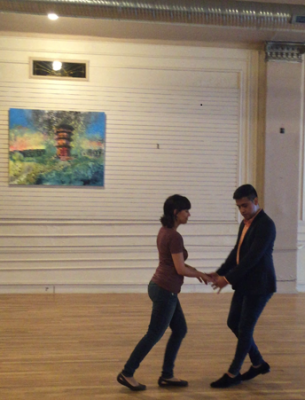
Fast forward to Monday evening, and I was dancing to quite a different tune- a salsa number, to be exact. My mom had convinced me to take Monday night lessons with her, and this was the end of the four-week cycle, meaning we were now officially *advanced* beginners. In comparison to swing, which can be jumpy and frenetic, salsa is smoother, and the steps are smaller. In our lesson, we learned a new combination, a long string of different moves all back to back, twirling and stepping in time with the music and each other. Despite not knowing the names of the other members of our class, we still felt a bond, having danced together for the past four weeks. Not only had all the dancing made me more coordinated, it had made me more connected- to my city, to my neighbors and friends, and even to my mother.
~Emilia Halvorsen
A Green and Leafy Surprise
Nothing destroys stereotypes like witnessing the eclectic group of people who attend themed booths or festivals. In 2015, I observed the diversity in the Baltimore vegetarian/vegan scene when working at a booth for the Vegetarian Resource Group during the Charles Village Festival.
The Charles Village Festival, now twenty-one years old, happened this summer at Wyman Park Dell, at Charles and 29th Streets in Baltimore, Maryland. It’s two days of vendors, games, live music, a 5K run, and a garden walk. At the vendor section last year, the Vegetarian Resource Group laid cookbooks, pins, and magazines on the table. Pumped up on caffeine and on the beautiful day, I asked every person who stopped by if they followed a vegetarian or vegan diet, or felt interested in it, and got many interesting responses. Some people had tried and hoped to finally succeed, some got a pet and wanted to stop eating meat, others felt it was healthier for their heart. But while the reasons and stories were interesting, the wide range of people with stories is what really stuck with me. Families with many children, bikers with studded jackets and long hair, recent immigrants, and businessmen stopped to talk.
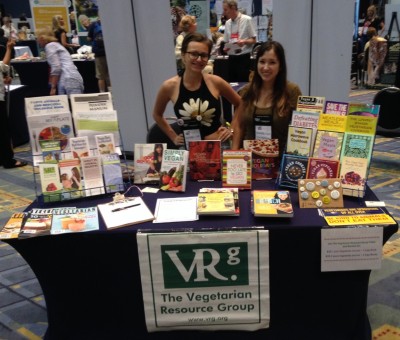
I couldn’t decipher one “most common” demographic – people from many different races, religions, and styles came and went. It would have surprised anyone with any assumptions about Baltimore and about vegetarians. Experiences like this one make you more conscious of how little you know about the people in your own city and neighborhood, and how many common connections you may uncover if you just throw any assumptions and talk. In a city such as Baltimore, known for its divisions, it’s especially important to remember.
